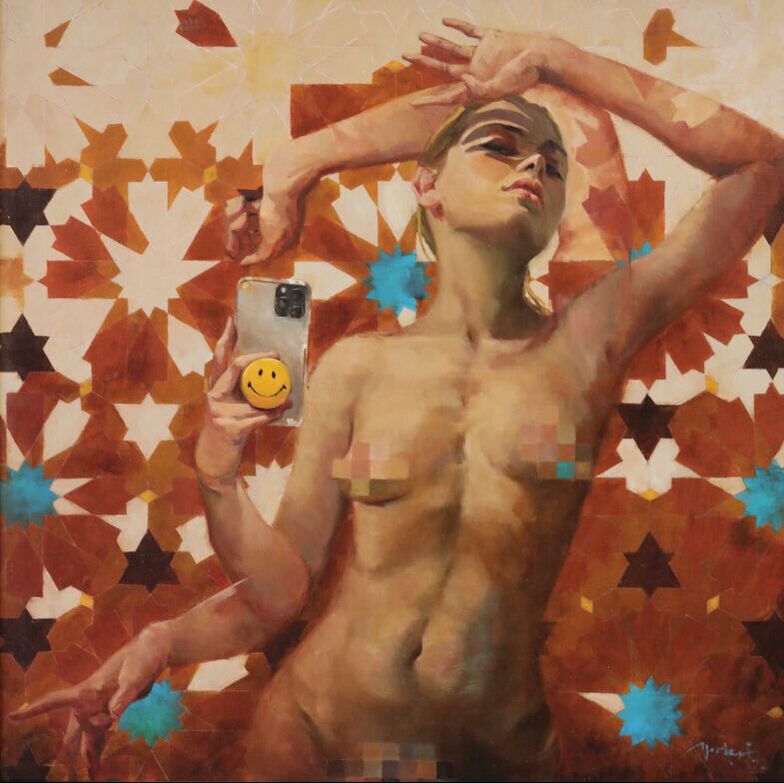The desire to create something from nothing has always taken part of the journey of Italian/Danish artist Marchesi. |
an article written by Mona Lisa Abramovich
Some kids are lucky. When asked what they want to do with their life, they just know their calling from an early stage and work hard toward achieving it, be that Astronaut or YouTuber. To the Italian/Danish artist Roberto Marchesi (b. 1977) the innate calling is to paint. Where this certainty comes from, Marchesi cannot answer, but it has been part of him for as long as he remembers. Growing up in Italy, on Sundays, Marchesi’s father would take him for a walk before lunch, visiting many of Milano’s churches and museums. Marchesi clearly remembers paying more attention to the murals, mosaics and paintings than the sermons and wonder how the artists managed to master such complex images and paint those scenes out of thin air. The seeds for Marchesi’s creativity were probably planted there and got the chance to grow when he was at school and supposed to pay attention to the teachers. Doodle to sketch to drawing all in the span of so many lessons. This desire to create something from nothing never left since and took many forms throughout his career. Looking back, Marchesi has always been involved in creative projects and been closely tied to a development process of play experiences digital or physical. The formal painting education of Marchesi, began almost 20 years ago at the Florence Academy of Art, at the time he was working as a concept artist for IO Interactive, a Danish Videogame developer. Even if daily work required the exclusive use of digital tools due to production constraints, the art foundation and fundamentals were the same as those thought in the classic atelier paint programs. After all, what is the difference between a portrait and a character design, a landscape and a game location, a still life or a loot chest?
Marchesi managed to convince his manager at the time to spend a summer in Florence studying Figure Painting and Still Life, where traditional approach to painting and materials is the main focus, and oils are considered not only the most complete of the paint mediums, but also the most archivable.
Oil colors have this reputation of being hard and dangerous to use, but that is not fair however it does require a bit of commitment and dropping the habit of putting a brush in your mouth! The slow drying time lends itself to lots of refinement and can be very forgiving especially when starting out, unlike acrylics or water colors. Marchesi works exclusively in oils and has found that having a dedicated space in his home or at a studio where there is no need to tidy up everything for the day is critical in order to use the medium correctly. Of course there is specific know how and cleanup, but not having to worry about setting up and closing down everything every time for the day was a game changer for Marchesi. Marchesi doesn’t have a favorite brand and keep changing his color palette, always searching, and experimenting. For example, right now he’s in love with a Michael Harding Cobalt Teal that he tries to use everywhere in his work, both as an underpainting shade or as a main hue. Marchesi chooses to start painting full time because the pressure to get stuff out had grown to strong after years working on other people’s ideas. It could be the nature of his paintings or his personality (probably both), but he requires a certain level of planning ahead and an almost final composition beforehand. Just attacking the canvas and landing a painting while he lets his intuition and happy accidents guide him, is something Marchesi has tried but that has seldom worked for him and his insecurity takes the upper hand in the process. Images, flavors, colors or themes they slowly build up in the back of his mind. Marchesi constantly gets inspiration from books, SoMe, museums or just life and lots of “What Ifs” bubble somewhere.
At one point the sketchbook or iPad of Marchesi comes out and he starts playing around with a specific idea. During this process his work is on the sloppy side and try to stay open to new inputs by constantly explore variations and compositions. More than half of his ideas never get past this stage. Spending a day sketching and not maturing a concept far enough to work on a larger scale, can be frustrating and leave a feeling of not having done anything for the today. But there is nothing worse for Marchesi than starting a painting on a half backed idea and struggle with it from the start. Nothing good comes out and leads to more pressure on the next piece. When a sketch is ready, Marchesi locks it and commit to a larger piece. He found that when following this preliminary steps the painting process becomes more enjoyable and much faster on top. The works of Marchesi might be planned; however it feels like the subjects chooses him more than the other way around. The ideas that make it to the sketching stage though, go through a filter based on his fascination with the old masters’ techniques and the desire to paint subjects that can stem only from present day. Topics are like the various tattoo series are chosen by how they well they represent issues that touch us and fill our time.
There are recurring themes like “Happiness” or the “Dream studies”, that due to their familiarity to Marchesi are great breaks in between the lager works. When working on this smaller formats, he can be more free and experiment with colors, techniques, materials. As there are fewer variables Marchesi gets better isolate the learnings. The creative and painting process is as important as what Marchesi’s painting, and he could almost be painting anything or anyone. Marchesi chooses to become a fulltime painter and leave a secure office life as working with brushes and colors is a more rewarding workflow, and the outcome is much more meaningful than delivering solutions to marketing promises! One aspect that Marchesi dedicates a lot of thought to, is what is his personal painting style or voice, and what is it that makes artworks stand out as his. Every artist has probably asked oneself the same question, and it is central to establishing a recognizable identity in the public.
Beauty is in the eye of the beholder; however, Marchesi has never been fond of “ugly” or unpleasant themes, and offense is not a goal in itself. Nor is it to please at all costs. Whenever Marchesi works on a painting, his aim is to set up a stage for the viewers that contains ideally equal amounts of tension, humour, provocation, and leaves them open to questions and interpretation. Contrast is fundamental to achieve this, and it can be applied to every element in a picture in relation to the rest present. Values, edges, brush strokes, colours, story all are affected by contrast to what surrounds them, and one of my Achilles’ heel is color. Colors is not natural to Marchesi, and he doesn’t have the gift of mixing tones that complement each other, and just feel right. Marchesi struggles with values and have a tendency to go high chroma. A good composition should drawn the viewer in, keep them guessing and leave them with wonder. Doesn’t matter if it is Figurative, Abstract or a Landscape as long as it doesn’t leave you indifferent. If a work is plain obtuse or to cryptic to understand, there is a risk of loosing the audience interest, and irrelevance must be an artists biggest fear.
When it comes to who influenced Marchesi, he feels like such an ignorant. He might know names and artworks, but context is often elusive to him, and art books can be so dry. Of course, there are a ton of artists that he has encountered and really liked, some he has moved past, while others he keeps revisiting and getting new understanding and learnings from as he grows himself as a painter. Marchesi remembers visiting the Uffizi as a child (there was no que or security like today) or the Museo della Scienza in Milan where all the DaVinci drawings are kept, or the Skagen at the very tip of Denmark and ask himself HOW was it possible to have such a deep understanding and mastery? As a kid Marchesi discovered early on book cover artists like the American artist Frazetta (1928 - 2010), the British artist Foss (b. 1968), the American artist Rockwell (1894 – 1978), or the Scottish painter Burns (1869–1941). They blew his mind, and he spent hours studying them in the old Paper Tiger and Dragon’s Dream collections. Here were artists that were as good as the old masters but painted cool stuff! One of his very favorites was the American artist Jeffery Catherine Jones (1944 - 2011), who’s personal works are master classes in delicacy and elegance. Fascination with comic books kicked in very early to, and Marchesi could lose himself with comics by Polish Bizley, French Moebius (1938 - 2012) or American artist Darrows (b. 1955), so many details to take in.
|
SUPPORTARTICULATE
www.articulate.nu SUPPORT Monday - Friday 8:00 - 16:00 [email protected] +45 30 48 19 81 Head Quarters VAT DK40953191 |
|












